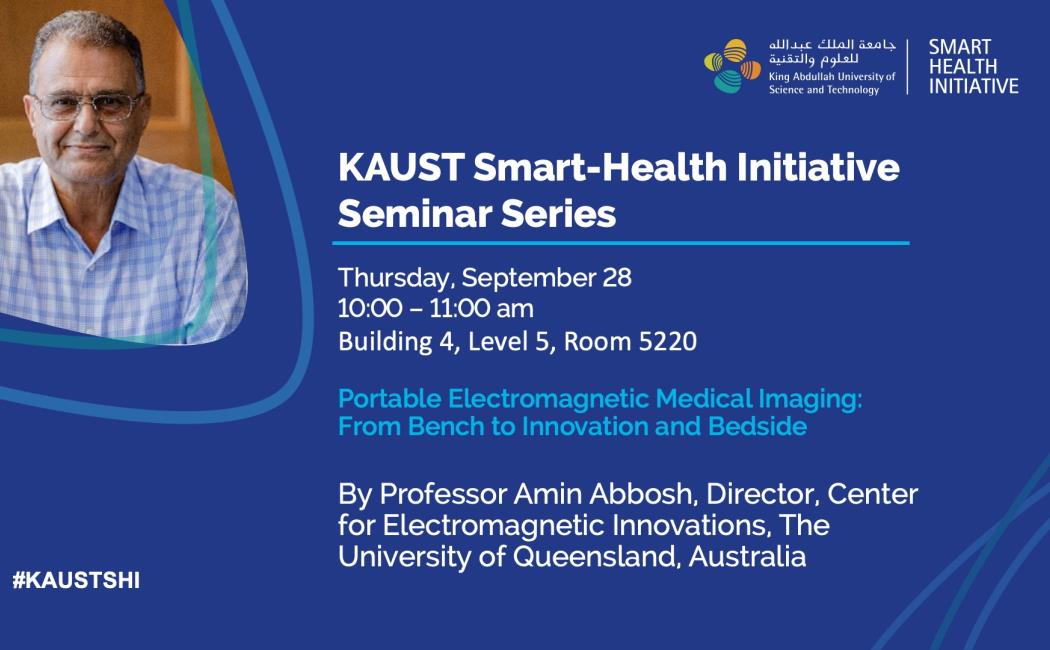
KSHI Seminar: Portable Electromagnetic Medical Imaging: From Bench to Innovation and Bedside
Please join us for the next KAUST Smart-Health Initiative (KSHI) seminar:
Portable Electromagnetic Medical Imaging: From Bench to Innovation and Bedside
Prof. Amin Abbosh, Director, Center for Electromagnetic Innovations, The University of Queensland, Australia
Abstract
The development of smart health technologies intertwined with innovation and entrepreneurship is vital to transform healthcare delivery with the aim to meet the ever-evolving needs of society. That noble aim can only be realized by translating cutting-edge research into clinical practices.
Biological tissues have specific dielectric properties, which are frequency dispersive. Any change in the physiological and pathological conditions of those tissues changes those dielectric properties, and thus the response of the affected tissues to electromagnetic (EM) waves transmitted using proper sensors/ antennas will change. EM imaging (EMI) utilizes that response change to image, detect and/or classify relevant pathology. Based on that concept, Prof Abbosh has researched, in the past ten years, and developed EMI as a disruptive medical imaging modality with far-reaching societal impact, applications, from early diagnosis to therapy and monitoring, and commercial opportunities. His dynamic 35-member team has built a series of clinical EMI prototypes for head imaging in stroke detection, torso imaging for pulmonary edema, congestive heart failure, fatty liver disease detection, skin scanner for the detection of melanoma, bloodless blood test, knee imaging, etc. In contrast to traditional tools, EMI is a portable point-of-care device that can be deployed in ambulances, rural clinics, and doctor’s offices, in addition to hospitals and medical centers. Moreover, since EMI is non-ionizing and non-invasive, it can be used frequently for real-time monitoring.
The journey toward building a clinical EMI modality was not easy. Since human tissues are lossy, while the allowed safe EM power is low, useful imaging signals are embedded in clutter, making it quite challenging to image internal human tissues using EMI. Additionally, the available information is limited due to the limited number of antennas/sensors and frequency bands that can be used. To address those challenges, Prof Abbosh developed novel structures supported by a hybrid suite of techniques that enable achieving more than 90% overall accuracy of detection and classification in clinical trials for stroke detection as an example. Those results will not have been achieved without building a multidisciplinary team with complementary skills in EM, AI, and Biomedical Signal Processing, working in a collaborative environment towards one main objective.
In this talk, Prof Abbosh will be discussing the roller coaster of his research journey with EMI, which followed a path that was rarely traveled. While his journey verified the potential of EMI, it also confirmed the significant associated challenges that should be addressed when aiming to translate research from the bench to innovation and bedside.
Bio
Professor and Director of Centre for Electromagnetic Innovations (ƐMAGIN) at The University of Queensland (UQ), Australia. Previously, Prof Abbosh was the Head of the School of ITEE-UQ, which includes five Departments (Electrical Engineering, Biomedical Engineering, Software Engineering, Data Science & Human Centred Computing). He also served as Director of Research and Director of Research Training at UQ. He has authored more than 500 papers, mainly on Electromagnetic Medical Imaging (EMI). He is the chief inventor of more than 20 patents that are licensed to the medical industry. His patents form the core IP of the publicly listed Australian company, EMvision Med Tech, and a start-up company. For his excellence in fundamental, applied, and translational research, he won many awards, including IEEE APS King Prize twice (2016 & 2019). UQ Excellence in HDR Supervision (2016) & Entrepreneurship Award (2018), and many best paper awards in premier IEEE conferences. He successfully led a 35-member team in more than 30 projects, including the Cooperative Research Centre, funded by the Australian Research Council and Industry with total funding of more than $20m.
